A Skeleton Trial Key to TRICHOLOMA in the Pacific Northwest
Prepared for the Pacific Northwest Key Council
by Coleman Leuthy 1996
Copyright © Pacific Northwest Key Council 1996, 1997, 2019, 2023
Minor revisions by Ian Gibson 2019, 2023
Photo copyright held by each photographer
Do not copy photos without permission
INTRODUCTION
Details of the two most recent revisions are after the key and photographs.
This key is a trial field key to species reported in the Pacific Northwest. The species marked with an asterisk need confirmation for the Pacific Northwest and some of them will not be included in the final key.
I Annulus present:
................................................................................Group 1
| Floccularia albolanaripes |
T. cingulatum |
| Floccularia luteovirens |
T. focale |
| T. aurantium |
T. murrillianum (T. magnivelare misapplied) |
| T. badicephalum |
T. robustum* |
| T. dulciolens |
T. vernaticum |
II Having a strong non-farinaceous odor:
................................................................................Group 2
| T. apium |
T. odorum* |
| T. bufonium* |
T. platyphyllum |
| T. inamoenum |
T. sulphureum group |
| T. lutescens |
|
III Color of cap:
A White to pale or pastel
................................................................................Group 3
| T. farinaceum |
T. subluridum |
| T. silvaticum* |
|
B Yellow, orange, reddish orange, green or with a green component
................................................................................Group 4
| T. aestuans* |
T. equestre group |
| T. atrofibrillosum |
T. intermedium |
| T. aurantio-olivaceum |
T. psammopus* |
| T. aurantium |
T. saponaceum group |
| T. davisiae |
T. subluteum* |
|
|
C Reddish brown or brown but not gray – black in the base color, fibrils may be +/- black
................................................................................Group 5
| T. ammophilum |
T. striatum* |
| T. fulvum group |
T. subumbrinum |
| T. imbricatum |
T. ustale* |
| T. muricatum / albobrunneum |
T. vaccinum |
| T. psammopus* |
T. venenatoides |
| T. stans* |
|
D Gray to black, especially fibrils, etc.
................................................................................Group 6
| T. acre* |
T. luteomaculosum* |
T. portentosum |
| T. argenteum* |
T. moseri group |
T. scalpturatum* |
| T. atrodiscum* |
T. mutabile |
T. squarrulosum group |
| T. atrosquamosum* |
T. nigrocystidium nom. prov. |
T. subacutum |
| T. atroviolaceum |
T. nigrum |
T. triste* |
| T. cingulatum |
T. orirubens* |
T. umbonatum* |
| T. huronense* |
T. pardinum |
|
* These species need confirmation for the Pacific Northwest.
KEY TO TRICHOLOMA
Group 1 – Species with an annulus – 10 species
1a Cap surface entirely some shade of yellow
................................................................................2
1b Cap surface not entirely yellow, or some other color
................................................................................3
2a Cap with brownish to blackish radiating fibrils, without upturned scales, surface slightly viscid only when moist.
................................................................................Floccularia albolanaripes (= Armillaria albolanaripes)
2b Cap with light colored, upturned scales, surface moist and sticky.
................................................................................Floccularia luteovirens (= Armillaria luteovirens)
3a (1b) Cap surface bright orange; stem uniformly orange below with almost concentric scale-flakes around the mid-portion, the upper part white
................................................................................T. aurantium
3b Cap surface orangish and/or of other colors
................................................................................4
4a Cap surface orangish, reddish orange to chestnut or date brown often with green tones; stem often tapering at base
................................................................................5
4b Cap surface either gray, or white to whitish gray with flattened fibrils; fibrils grayish or cinnamon-brown to chestnut or vinaceous
................................................................................6
5a Cap orange to orange brown, often lighter on the margin, at times showing some olive-green tints; strong farinaceous smell especially when split open; stem short and stout
................................................................................T. focale (including T. zelleri)
5b Cap red brown to yellow brown, browner than above, may be lighter on the margin; slightly farinaceous smell; stem less short and less stout
................................................................................T. badicephalum
5c Cap chestnut to coppery or reddish brown; stem longer and cylindrical than T. focale, known from Europe and Japan, not known to occur in North America
................................................................................T. robustum (needs confirmation for PNW)
6a (4b) Cap gray, brownish or bluish
................................................................................7
6b Cap white and or with few to nearly covered by brown fibrils so as to appear brown
................................................................................8
7a Cap gray to bluish gray often developing brown or sometimes olivaceous tones, sometimes overlaid with white cottony or fibrillose veil remnants forming a patch in center of cap; smell distinctive of cucumber or watermelon rind.
................................................................................T. vernaticum (== Armillaria olida)
7b Cap gray-beige to gray-brown, yellowing in age, smooth to finely and radially fibrillose; odor farinaceous - mealy
................................................................................T. cingulatum
8a (6b) Cap white, sometimes streaked or with splotches of brown (? grayish to grayish brown); a robust species with cap 8 - 20 cm or larger; stem expanded at base often with brown streaked areas; odor distinctly spicy-aromatic.
................................................................................T. murrillianum (Tricholoma magnivelare is a misapplied name)
8b Cap base color white, but cap appearing deep brown by flattened cinnamon-brown to chestnut or vinaceous fibrils, sometimes separating in age revealing a whitish or pinkish flesh; stem also covered with brown fibrils; smaller and more slender cap 4 - 12 cm broad; odor spicy-aromatic.
................................................................................T. dulciolens
Group 2 – Species with a strong odor – 7 species
1a Cap reddish brown to purple reddish brown
................................................................................T. bufonium (needs confirmation for PNW)
1b Cap white to yellow
................................................................................2
2a Odor of celery
................................................................................T. apium
2b Odor of coal tar gas – sulfur aromatic, noxious somewhat sweetish, without fruity or floral component
................................................................................3
2c Odor of coal tar gas, with a fruity or floral component, or with farinaceous taste
................................................................................5
3a Cap, gills, stem, and flesh yellow
................................................................................T. sulphureum group
3b Cap whitish to pale yellow gray or yellow buff
................................................................................4
4a Cap dingy white to pale yellow gray; gills white sometimes blackening; stem whitish yellow, can brown at base, northern distribution in Pacific Northwest
................................................................................T. inamoenum
4b Cap white to yellow buff; gills white to light buff, on aging dark yellow; stem whitish, southern distribution in Pacific Northwest
................................................................................T. platyphyllum
5a (2c) Does not bruise yellow; odor of jessamine blossoms to nutty, taste farinaceous; cap grass yellow to yellow with a brown center; gills yellow fading to buff; stem yellow fading to buff, bruising brown at base
................................................................................T. odorum (needs confirmation for PNW)
5b Gills and stem spotting yellow when touched; odor complex, a mix of pungent, disagreeable, and coal tar-like, with a floral or fruity component, taste mild to somewhat acrid or bitter; cap white, becoming creamy white to pale ochraceous, staining yellow to brown when handled or when old; gills white to cream, becoming yellowish when old
................................................................................T. lutescens
Group 3 – CAP white – pale, pastel (see also the strongly odorous species in Group 2)
1a Cap to 4 (5) cm
................................................................................2
1b Cap to 7 or 8 cm
................................................................................3
2a Cap white with a bluish tint, centered blackish, prominent umbo
................................................................................T. subluridum (described from a single fruiting body)
2b Cap white, subumbonate
................................................................................T. farinaceum (considered to be an ambiguous name)
3a (1b) Cap whitish, dry, glabrous
................................................................................T. silvaticum (needs confirmation for PNW)
3b Cap cream to dingy white with fine brown to gray fibrils.
................................................................................A white form of Tricholoma scalpturatum (see Group 6) where T. scalpturatum is considered with T. moseri group)
Group 4 – CAP yellow, orange, reddish orange, green or with a green component – 12 species
1a Cap somewhat greasy-looking, not viscid; greenish gray, olive, yellowish olive, grayish brown, gray; stem pinkish inside near base and often outside, odor mild to farinaceous or soapy or rancid with a sweet overtone or “of washrooms”
................................................................................T. saponaceum group
1b Not with these characters
................................................................................2
2a Stem slender and silky, usually more than 8 times as long as wide; cap dry, orange to orange brown; stem with orangish to brownish fibrils or scales; odor mild
................................................................................T. aurantio-olivaceum
2b Not with these characters
................................................................................3
3a Cap viscid, orange to orange-brown or red-brown, sometimes splashed with olive or entirely olive; stem with belts of rusty orange scales; odor farinaceous
................................................................................T. aurantium
3b Not with these characters
................................................................................4
4a Cap yellow to brown or sometimes olive-yellow, viscid when wet, without conspicuous black to brown radiating fibrils; stem white to yellow
................................................................................5
4b Not with these characters
................................................................................6
5a Gills yellow
................................................................................T. equestre group
5b Gills white
................................................................................T. intermedium (a synonym is T. leucophyllum)
6a (4b) Odor farinaceous
................................................................................7
6b Odor mild
................................................................................8
7a Cap slightly viscid, with yellowish or greenish yellow background, both disk and conspicuous radiating fibrils are blackish or dark brown, cap becoming broadly convex with an umbo; gills white or tinged yellow, stem smooth, white to yellowish, odor mild or slightly farinaceous
................................................................................atrofibrillosum
7b Cap dry, not having conspicuous black to brown radiating fibrils; cap with an acute umbo, yellowish green, yellowish buff, pale buff, gray-brown, or brownish gray, darker on the umbo; stem that is light greenish yellow and silky-fibrillose, stem base white or tinged vinaceous; odor farinaceous
................................................................................T. davisiae
8a (6b) Cap slightly viscid, with yellowish or greenish yellow background, both disk and conspicuous radiating fibrils are blackish or dark brown, cap becoming broadly convex with an umbo; gills white or tinged yellow, stem smooth, white to yellowish, odor mild or slightly farinaceous
................................................................................atrofibrillosum
8b Cap dry, light yellowish green, greenish yellow with brown disc and often elsewhere, occasionally streaked with gray fibrils; stem silky-fibrillose, very pale yellow-green, odor mild
................................................................................T. aestuans (not confirmed for PNW)
Group 5 – CAP reddish brown or brown – 11 species
1a Cap fibrillose to scaly to the touch, dry
................................................................................2
1b Cap smooth to the touch (but may be innately fibrillose), moist to viscid in rainy weather
................................................................................5
2a Cap color white with brown scales, or yellowish brown
................................................................................3
2b Cap color reddish brown
................................................................................4
3b Cap with fibrils arranged +/- in concentric rows of brown appressed scales
................................................................................T. venenatoides
3a Cap with radially aligned fibrils, appressed when young but becoming scaly in age; usually under larch
................................................................................T. psammopus (not confirmed for PNW)
4a (2b) Young buttons with cortina; stem generally hollow; habit usually gregarious or cespitose; cap color reddish brown (rusty brown), buff ground color between scales readily apparent; cap surface broken into distinct scales
................................................................................T. vaccinum
4b Young buttons lacking cortina; stem generally solid; usually solitary or scattered; cap color duller, darker brown, ground color not readily apparent
................................................................................T. imbricatum
5a (1b) Gills and stem flesh yellow; stem surface fibrillose, yellow to brownish; cap margin may be striate when young.
................................................................................T. fulvum group
5b Gills and stem flesh white to pallid, maybe spotting rusty red-brown in age
................................................................................6
6a Always growing under trees in the genus Populus (poplars, cottonwoods, aspens, etc.); growth in close-packed groups
................................................................................T. ammophilum
6b Habitat with either conifers or hardwoods, but not limited to Populus species; growth habit various
................................................................................7
7a Cap color dirty yellowish brown; cap shape subconic; surface smooth but innately fibrillose and virgate, viscid but soon dry
................................................................................T. subumbrinum
7b Cap color reddish brown; cap shape not subconic, other features various
................................................................................8
8a Cap margin usually spotted with drops or dark spots, cap and gill edges may darken in age, gills may have reddish brown spots or stains; odor farinaceous; stem usually short; usually with pines or spruce, or odor mild
................................................................................T. fulvum group
8b Cap lacking dark spots described above, or odor mild; other features varied
................................................................................9
9a Odor mild; usually with deciduous trees; cap red-brown with olivaceous tinge and blackening in age; gills white, then rust-spotted, old edges blackening
................................................................................T. ustale (not confirmed for PNW)
9b Odor farinaceous or not; usually under conifers, especially pines
................................................................................10
10a Stem silky-fibrillose with irregular belts of recurved fibrils, pruinose at top, often somewhat rooting, stem overall becoming brown to brownish orange, darkening from base up or bruising with handling; cap streaked from innate radiating fibrils, margin often ribbed
................................................................................T. muricatum (could be synonym of next species)
10b Stem apex clearly delimited by a pseudoannular white zone, length average; cap margin obscurely striate.
................................................................................T. albobrunneum (= T. striatum of some authors)
10c Stem with longitudinal fibrils sometimes cracking to form transverse bands but lacking real annular zone; stem rather tall and slender, +/- pointed at base; cap not striate
................................................................................T. stans (not confirmed from PNW)
Group 6 – CAP gray to black or the primary color of the fibrils, etc. – 20 species
1a Cap viscid
................................................................................2
1b Cap dry
................................................................................5
2a Cap or fibrils with gray to black or gray brown
................................................................................3
2b Cap white to gray or cream
................................................................................4
3a Cap fibrillose-scaly at first, dark gray overall, margin soon becoming lighter gray, moist to tacky, 3.5 - 10 cm
................................................................................T. nigrum
3b Cap with innate dark gray fibrils, sometimes tints of brown, yellow, or purple, viscid to slimy, 6 - 15 cm
................................................................................T. portentosum
3c Cap glabrous, viscid, 3 - 7 cm
................................................................................T. nigrocystidium Ovrebo nom. prov.
4a (2b) Cap light-medium gray, may have large irregular white areas, broadly convex to +/- plane, often with a low umbo, disc dark brownish gray
................................................................................T. mutabile
4b Cap brown gray to olivaceous, cream brown, or white, somewhat conic prominent umbo, disc dusky brown, margin wavy
................................................................................T. umbonatum (not confirmed for PNW)
5a (1b) Mature cap of larger expanded specimens over 10 cm (10 - 20 cm) broad
................................................................................6
5b Mature expanded caps less than 12 cm
................................................................................10
6a Innately interwoven radiating fibrils, scattered squamules, firm and short stature; stem 2.5-6 cm long, cortina in button stage; odor mild, taste bitter to acrid
................................................................................T. acre (not confirmed for PNW)
6b Fibrillose, scaly, or squamulose +/- upturned; stem mostly longer than 5 cm, no cortina; odor farinaceous, taste farinaceous or mild
................................................................................7
7a Cap, gills, or stem with violet or pinkish coloration or droplets
................................................................................8
7b Mushroom without pinkish or violet coloration
................................................................................9
8a Cap black violet gray, 6-13 cm; gills gray pinkish tinged; stem scattered squamules darkening to violaceous or +/- yellow, 6-15 cm long
................................................................................T. atroviolaceum
8b Cap pale gray to darkish gray - pinkish, 6-9 (12) cm, often beaded drops of clear or pink fluid or streaked pinkish; stem silky to appressed fibrils, scales, often beaded with clear or pinkish drops of fluid, 4-8 cm long
................................................................................T. huronense (not confirmed for PNW)
9a (7b) Cap dark grayish brown to dull yellowish brown to nearly gray, 4-12 cm; gills light buff to light gray, in age often yellow, close; stem silky fibrils some projecting, 4-8 cm long
................................................................................T. luteomaculosum (not confirmed for PNW)
9b Cap with pale background, gray black to gray brown scales, 7-18 (20+) cm; gills dull white, +/- toothed; stem glabrous or smooth, base stains +/- yellow or rusty, 5-15 cm long
................................................................................T. pardinum
10a (5b) Cap, gills, or stem with pink, red, or violet tones, or bruising or becoming so in age or with clear pink - red droplets on cap edge or on stem
................................................................................11
10b No apparent coloration of pink, red, or violet to purple
................................................................................18
11a Gills white to gray, light gray buff, and with pinkish or reddish tones
................................................................................12
11b Gills white, dull white to gray, and or dingy buff to cream
................................................................................15
12a Cap with violet - violaceous tones (see 8a.)
................................................................................T. atroviolaceum
12b Cap dark brown gray - sooty gray
................................................................................13
13a Disc dark gray, gray-black, radially fibrillose-scaly +/- flushed pink, stem base reddish; after picking cap and gills turn reddish, bruised stem +/- turning reddish or green-blue
................................................................................T. orirubens (not confirmed for PNW)
13b Cap dark brown gray
................................................................................14
14a Stem drab light gray buff with a light ground color, silky fibrillose; taste bitter
................................................................................T. atrodiscum (not confirmed for PNW)
14b Stem gray brown, color of cap, covered with squamulose fibrils; taste mild
................................................................................T. squarrulosum group
15a (11b) Cap conical, acute umbonate, light lilac tones, streaked surface, long innate radiating fibrils, silver gray - gray, stem white flushed pale pink, purplish pink at base, has a cortina, odor mild/absent, taste bitter
................................................................................T. subacutum
15b Cap convex to plane, with a low umbo or depressed
................................................................................16
16a Disc black, cap black-gray and with dark red-brown tomentose, scaly, fibrils, gills white-gray to dull cream, dotted black on edge, stem equal, pale gray, taste mild
................................................................................T. atrosquamosum (not confirmed for PNW)
16b Cap smoky gray or gray red brown
................................................................................17
17a Cap light smoke-gray to moderately pinkish, fibrillose gray cuticle becoming broken, appressed gray spotlike scales around disc and over margin, white flesh showing, often beaded drops of clear pink fluid or streaked pinkish along margin, gills dull white, stem clavate, silky and often pink beaded drops above, appressed-fibrillose scales below, pale gray, odor & taste farinaceous (see 8b)
................................................................................T. huronense (not confirmed for PNW)
17b Cap speckled salty gray-brown on a red-brown ground color, gray sooty-scaly, gills white to gray, stem center gray over slate, above and below pale, sparse cortina, odor weak fungoid, taste mild
................................................................................T. triste (not confirmed for PNW, here considered part of the T. moseri group)
18a (10b) Partial veil or cortina present but often fleeting - check buttons
................................................................................19
18b No evident cortina or veil
................................................................................24
19a Veil normally a persistent, flaring, cotton-membranous one that in age is often appressed to the stem, reticulate fibrils on cap surface likely part of the veil, white discoloring yellow
................................................................................T. cingulatum
19b Veil a cortina, not persistent
................................................................................20
20a Cap conic, acute umbonate silver gray to gray, (stem base not always flushed pink to purplish pink) (see 15a)
................................................................................T. subacutum
20b Cap more convex to low umbonate to plane or depressed
................................................................................21
21a Cap light medium gray, a firm good sized species (see 6a)
................................................................................T. acre (not confirmed for PNW)
21b Cap darker to gray-blackish or brown
................................................................................22
22a With moderately spaced squamules, odor and taste farinaceous, veil a cortina of thin white fibrils, occasionally evident on stem for a brief time
................................................................................T. scalpturatum (not confirmed from PNW and here considered a member of T. moseri group)
22b Cap densely fibrillose-squamulose to granulose, odor and taste absent or week and mild
................................................................................23
23a Stem white to very pale gray, white to grayish surface fibrils projecting, silky; cap gray, dark drab to dark brown gray; veil a cortina, white to grayish fibrils, at times leaving a soon disappearing zone of fibrils on midstem to upper stem
................................................................................T. moseri group
23b Stem gray over slate, mid to lower sooty-scaly, pale on upper and (lower) part; cap speckled salty gray-brown on red-brown (ochraceous) ground, gray sooty-scaly; veil a sparse cortina
................................................................................T. triste (not confirmed for PNW, here considered part of the T. moseri group)
24a (18b) Odor mild, aromatic - sweet/fruity, fungoid, or absent, taste mild or bitter
................................................................................25
24b Odor farinaceous, taste farinaceous, test with PDAB ( - )
................................................................................28
25a Odor sweet/fruity or mild, taste bitter and a positive test with PDAB (+) = bright pink all parts:
................................................................................
a Odor sweet/fruity. No chemical data, but mild odor & bitter taste here shows pattern of PDAB (+) (see 13a)
................................................................................T. orirubens (not confirmed for PNW)
b Odor mild; cap gray silvery, generally with buff near edge, disc dense, margin with concolorous innate fibrils, streaked but not distinctly banded, stem white to sordid buff, stem silky-fibrillose with surface fibrils projecting, often pruinose at apex
................................................................................T. argenteum (not confirmed for PNW)
c Odor mild (see 6a)
................................................................................T. acre (not confirmed for PNW)
d Odor mild (see 14a)
................................................................................T. atrodiscum (not confirmed for PNW)
e Odor mild (see 15a)
................................................................................T. subacutum
25b Odor mild, farinaceous, fruity-peppery, taste farinaceous or farinaceous-bitterish or mild, test with PDAB ( - )
................................................................................26
26a Odor farinaceous to mild or fruity-peppery, taste farinaceous or farinaceous-bitterish or mild (see 16a) for other characters)
................................................................................T. atrosquamosum (not confirmed for PNW)
26b Odor mild or weak fungoid, taste mild
................................................................................27
27a Cap dark gray drab to blackish or dark brown gray, appressed fibrils + recurved or squamulose (see 23a)
................................................................................T. moseri group
27b Cap speckled salty gray brown on red brown ground with gray sooty scales (see 23b)
................................................................................T. triste (not confirmed for PNW, here considered part of the T. moseri group)
28 (24b) Cap convex to conical umbonate, disc almost black, margin almost slate black, dark to light gray - silvery or gray brown, finely tomentose, appressed innate radial fibrils to floccose then scaly; stem white to gray white, smooth, apex pruinose
................................................................................T. moseri group
PHOTOGRAPHS
Copyright to each photograph is held by the person named under the photograph.
Do not use without permission.
Tricholoma ammophilum
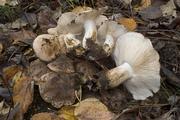
Andrew Parker |
Tricholoma apium
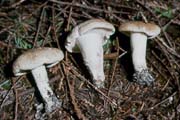
Paul Kroeger
|
Tricholoma atrofibrillosum
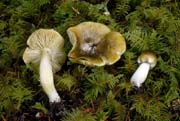
Steve Trudell
|
Tricholoma atroviolaceum
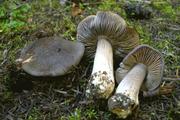
Andrew Parker
|
Tricholoma aurantium
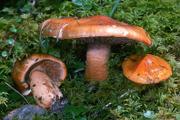
Michael Beug
|
Tricholoma badicephalum
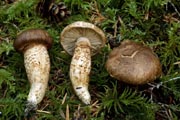
Steve Trudell
|
Tricholoma cingulatum
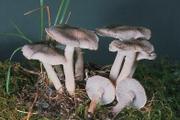
Ben Woo
|
Tricholoma davisiae
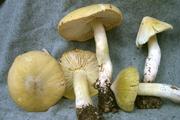
Andrew Parker
|
Tricholoma dulciolens
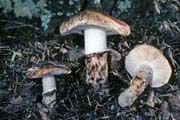
Michael Beug
|
Tricholoma equestre group
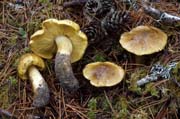
Steve Trudell
|
Tricholoma focale
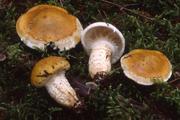
Andrew Parker
|
Tricholoma fulvum group
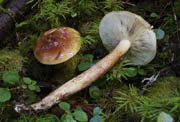
Andrew Parker
|
Tricholoma imbricatum
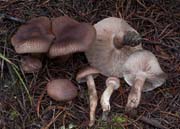
Andrew Parker
|
Tricholoma inamoenum group
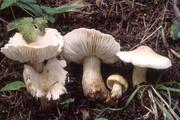
Andrew Parker
|
Tricholoma intermedium
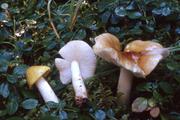
Andrew Parker
|
Tricholoma lutescens
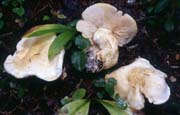
Andrew Parker
|
Tricholoma moseri group
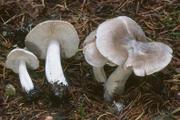
Michael Beug
|
Tricholoma muricatum
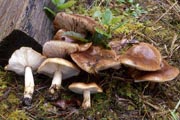
Steve Trudell
|
Tricholoma murrillianum
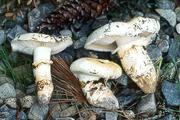
Paul Kroeger
|
Tricholoma pardinum
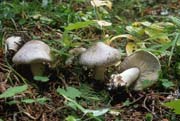
Andrew Parker
|
Tricholoma portentosum
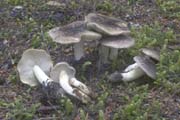
Andrew Parker
|
Tricholoma saponaceum group
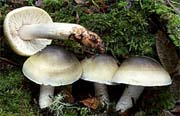
Boleslaw Kuznik
|
Tricholoma subacutum
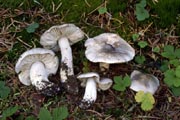
Steve Trudell
|
Tricholoma sulphureum group
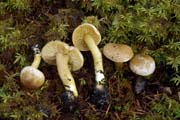
Steve Trudell
|
Tricholoma vaccinum
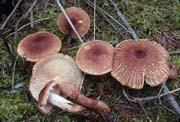
Andrew Parker
|
Tricholoma vernaticum
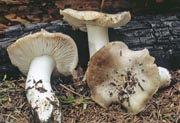
Michael Beug
|
Floccularia albolanaripes
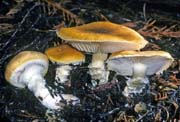
Kit Scates Barnhart
|
Floccularia luteovirens
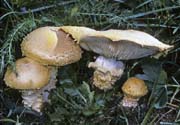
Kit Scates Barnhart
|
Copyright to each photograph is held by the person named under the photograph.
NOTE ON 2023 REVISION
The details of the two revisions are not essential to the use of the key, which retains its original structures. The reasons for name changes are discussed in the revisions.
The 2023 revision is a response to the following reference.
Trudell, Steven A., P. Brandon Matheny, Andrew G. Parker, Matthew Gordon, Diantha B. Dougil, Erica T. Cline. 2022. Pacific Northwest Tricholomas: Are We Using the Right Names? Published by the Authors.
Tricholoma ammophilum replaced the misapplied European name Tricholoma populinum.
Tricholoma subacutum replaced the misapplied name Tricholoma virgatum. T. argenteum has also be misapplied to T. subacutum.
Tricholoma atrofibrillosum replaced the misapplied European name Tricholoma sejunctum as formerly used here. There is another clade documented from Ontario, North Carolina and Alaska that is close to or identical with Tricholoma subsejunctum Peck. Both clades are represented in Alaska. In the key above we have replaced T. sejunctum group with T. atrofibrillosum and revised the short description. The comment about varieties of T. sejunctum has been eliminated.
Tricholoma lutescens replaced the misapplied European name Tricholoma sulphurescens. The short description in the key was revised.
Tricholoma badicephalum has been mistaken for Tricholoma focale and Tricholoma robustum in the pastbut T. focale occurs in the Pacific Northwest too.
Tricholoma dulciolens was supported as the correct name for what had been known as Tricholoma caligatum.
Tricholoma venenatoides is a species first described in 2021. It had been referred to as Tricholoma venenatum found in eastern North America. We have replaced the references in the key above applying to Tricholoma venenatum with Tricholoma venenatoides.
Tricholoma megalophaeum is a species first described in 2021. It is not included above but collections were examined from California and Washington State.
Tricholoma inamoenum and Tricholoma platyphyllum could be resolved as two species in the Pacific Northwest, the latter with a more southern distribution including Washington State (holotype), Oregon (epitype), and California, and the former with a more northern distribution including at Alaska and at least the northern part of British Columbia. The distributions could overlap.
Tricholoma sulphureum was considered an unresolved complex in Trudell et al. (2022), and we have redesignated it in the key above as Tricholoma sulphureum group. The name Tricholoma odorum could be considered part of this group, but the concept needs to be clarified.
T. saponaceum senso lato was accepted by Trudell et al. (2022). Tricholoma saponaceum is changed in the key above to Tricholoma saponaceum group. Trudell et al. (2022) suggested Tricholoma equestre be considered a group and that usage is followed in the key above. Tricholoma aurantium sensu lato was accepted by Trudell et al. (2022) for the Pacific Northwest. Tricholoma fulvum sensu lato is a designation used by Trudell et al. (2022); they also refer to the wider Tricholoma fulvum group – Tricholoma fulvum is replaced in the key above by Tricholoma fulvum group. T. pessundatum group in Trudell et al. (2022) is a name applied in a subclade of the Tricholoma fulvum sensu lato clade, but those sequences do not match the sequence of the Tricholoma pessundatum epitype from Europe, and the correct name(s) are unclear. In the key above, references to Tricholoma pessundatum are changed to Tricholoma fulvum group. Trudell et al. (2022) considered Tricholoma ustale unlikely for the Pacific Northwest, and references to it in the key above are changed to Tricholoma fulvum group. Trudell et al. (2022) did not find Tricholoma stans among their PNW collections.
Tricholoma cingulatum was considered to be likely to be likely for the PNW in Trudell et al. (2022) but remains to be confirmed. Tricholoma muricatum (or T. albobrunneum if they are synonymous) was considered likely but needing confirmation. Tricholoma striatum was listed as a synonym of T. albobrunneum in Trudell et al. (2022).
The following species also remain to be confirmed for the Pacific Northwest according to Trudell et al. (2022). Tricholoma atrosquamosum, Tricholoma aestuans, Tricholoma bufonium, Tricholoma psammopus (although an Oregon collection seemed close), Tricholoma silvaticum, and Tricholoma subluteum. The following species were considered unlikely to occur in the Pacific Northwest by Trudell et al. (2022): Tricholoma acre, Tricholoma atrodiscum, Tricholoma huronense, Tricholoma luteomaculosum, Tricholoma orirubens, Tricholoma scalpturatum, Tricholoma umbonatum, and Tricholoma ustale.
The presence of Tricholoma bufonium remained unresolved.
Tricholoma farinaceum, though described by Murrill from Washington, was considered in Trudell et al. (2022) to be an ambiguous name. Tricholoma subluridum was described by Murrill from Oregon, but was described from a single fruitbody.
Tricholoma moseri is the best confirmed representative of a group of generally small grayish Tricholomas with cap surfaces that are felty or finely scaly, and (generally) mild to farinaceous odor and taste. Trudell et al. (2022) said, "For now, we accept the existence of T. moseri in the PNW.” Some European names have been used for this group. Trudell et al. (2022) listed Tricholoma myomyces and Tricholoma terreum as having been misapplied to this species. Specimens identified as Tricholoma triste (in Europe including a neotype, and Colorado) and T. bonii (in Europe including the holotype) seem to be related as well. Other collection within the broader clade 17 of Trudell et al. (2022) were labeled as T. scalpturatum, T. cingulatum, T. argyraceum, and T. inocybeoides (collections not from the Pacific Northwest). For the purposes of the key above, we include mention of T. scalpturatum as being in the T. moseri group for now but T. scalpturatum remains to be confirmed for the Pacific Northwest. The species T. cingulatum is distinguished from the T. moseri group by a cottony persistent ring. T. subacutum could be confused with the T. moseri group but has a radial arrangement of cap fibrils.
NOTE ON 2019 REVISION
The following species were added:
1) Tricholoma apium with an odor of celery, a whitish cap and a stem that often narrows downward,
2) Tricholoma nigrum described in 1996 from Oregon,
3) Tricholoma aurantio-olivaceum originally described from Washington, and
4) Tricholoma muricatum in the Tricholoma pessundatum group, described by K. Shanks as a new species from California and documented from Washington and Oregon by S. Trudell. Other species in the T. pessundatum group as outlined by D. Arora are T. albobrunneum, T. fulvum, T. pessundatum, T. ustale, and T. ustaloides. All of these have been reported from the Pacific Northwest and backed by herbarium vouchers at the University of Washington or University of British Columbia, but they all have an asterisk in the key indicating that confirmation is required, ideally by molecular means.
The publication of Tricholomas of North America – A Mushroom Field Guide by A.A. Bessette, A.R. Bessette, W.C. Roody, and S.A. Trudell in 2013 provided a much needed resource.
This field guide supported the concept of T. aurantio-olivaceum – it is not clear why it was left out of the original key. It also mentioned reports of several other Tricholoma species from the Pacific Northwest which if confirmed should be added to the key. These include T. dryophilum, said by Bessette et al. to have been reported under Garry oak in southern Washington, and T. moseri, said by Bessette et al. to have been reported from the Washington Cascade Mountains. They also said that a collection from Idaho provided a 99% DNA sequence match with a French collection of T. arvernense, and similar collections later came to light in Oregon.
The definition of Group 2 was changed to “Having a strong non-farinaceous odor”. The logic in Group 4 was improved. Tricholoma sejunctum and T. subsejunctum were combined as Tricholoma sejunctum group as it is not clear what the correct name is [see 2023 update where T. atrofibrillosum begins to be used for these observations]. The undescribed ‘tea-green’ species was eliminated as it may represent Hygrophorus caeruleus.
- END -




























